Health Conditions of ‘Veteran Trees’ and Climate Change
Abstract
1. Introduction
- What are the physiological vitality and structural integrity conditions of veteran Zelkova serrata trees under different site environments within the same region?
- How are long-term climatic variables (e.g., land surface temperature, LST; vapor pressure deficit, VPD) associated with the physiological vitality (SPAD index) and structural integrity (SoT grade, live crown ratio) of veteran trees?
- What implications do these findings have in evaluating the climate change vulnerability of veteran trees and developing effective conservation and management strategies?
2. Materials and Methods
2.1. Study Scope and Area
2.2. Research Method
2.2.1. Research Framework
2.2.2. Diagnosis of Tree Growth Status
- (1)
- Growth Status of Trees
- (2)
- Visual Tree Assessment (VTA)
- Tapering—The ratio of tree height to diameter at breast height (DBH); a value greater than 60 indicates a high level of structural instability [27].
- Live Crown Ratio—The proportion of the live crown height to the total tree height; a ratio ≥ 0.6 is considered safe, whereas a ratio < 0.2 is evaluated as vulnerable.
- Branch Attachment Strength—The ratio of branch diameter to stem diameter; a value ≥ 0.75 is regarded as having a high risk of structural failure.
- Branch Crotch Angle—The angle between the branch and the stem; when the angle is <30°, the risk is considered high, and narrow V-shaped crotches are prone to splitting during strong winds of heavy snowfall.
- (3)
- Sonic Tomography (SoT)
2.2.3. Analysis of Tree Growth Environment
- Satellite Image-Based Assessment of Environmental Change
- Soil Sampling and Analysis
2.2.4. Analysis of Climatic and Environmental Changes
- Analysis of Climate Variable Trends
- Mean Vapor Pressure Deficit (VPD_mean) and mean Relative Humidity (RH_mean);
- Moisture supply: total accumulated precipitation (precip_sum) and number of dry days (dry_days);
- High temperature exposure: number of days with daily maximum temperature ≥ 30 °C (hot30_days).
- Provisional Sen’s slope was removed;
- lag-1 autocorrelation in the residuals was eliminated;
- MK test was performed after restoring the trend.
- Cloud and shadow masking using the QA_PIXEL band;
- Extraction of radiance from the ST_B10, followed by atmospheric correction and application of conversion coefficients to derive brightness temperature [32];
- Calculation of the Normalized Difference Vegetation Index (NDVI) using the SR_B5(NIR) and SR_B4(Red) bands.
3. Results
3.1. Tree Growth Status
3.1.1. Current Growth Characteristics
3.1.2. Visual Tree Assessment
3.1.3. Internal Structural Integrity Assessed by Sonic Tomography
3.2. Analysis of the Tree Growth Environment
3.2.1. Satellite Image-Based Assessment of Surrounding Environment Changes
3.2.2. Soil Environment
3.3. Climatic Changes and Tree Growth Status
3.3.1. Trends in Climate Variables
3.3.2. Spatial Distribution of LST
4. Discussion
- Mitigation of water and heat stress (e.g., soil moisture supplementation, crown relief pruning, and microclimate improvements);
- Proactive reinforcement and risk management for structurally vulnerable individuals;
- Integrated pest and disease monitoring.
5. Conclusions
Author Contributions
Funding
Institutional Review Board Statement
Informed Consent Statement
Data Availability Statement
Acknowledgments
Conflicts of Interest
Abbreviations
| VPD | vapor pressure deficit |
| LST | Land surface temperature |
| SPAD | Soil plant analysis development |
| LCR | Live crown ratio |
| VTA | Visual tree assessments |
| SoT | Sonic tomography |
| DBH | Diameter at breast height |
| TH | Tree height |
| BD | Branch diameter |
| SD | Stem diameter |
| EC | Electrical conductivity |
| USDA | United states department of agriculture |
| KMA | Korea Meteorological administration |
| AWS | Automatic weather system |
| RH | Relative humidity |
| MK | Mann–Kendall |
| TFPW-MK | Trend-free-pre-whitening Mann–Kendall |
| GEE | Google Earth Engine |
| Fv | Fraction vegetation |
| NDVI | Normalized difference vegetation index |
| CDD | Consecutive dry days |
| SEEI | Soil ecological and environmental index |
Appendix A
Appendix A.1

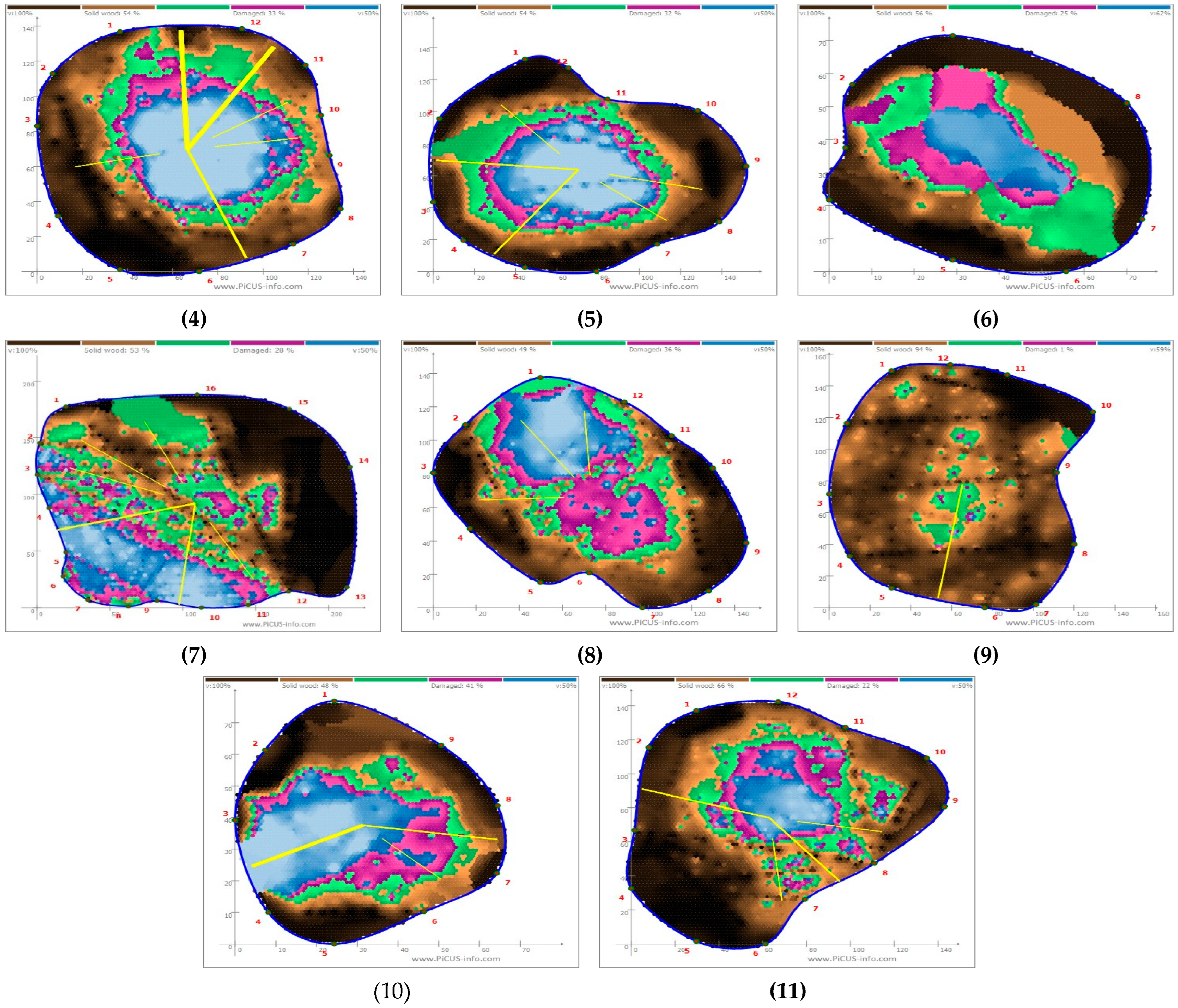
Appendix A.2

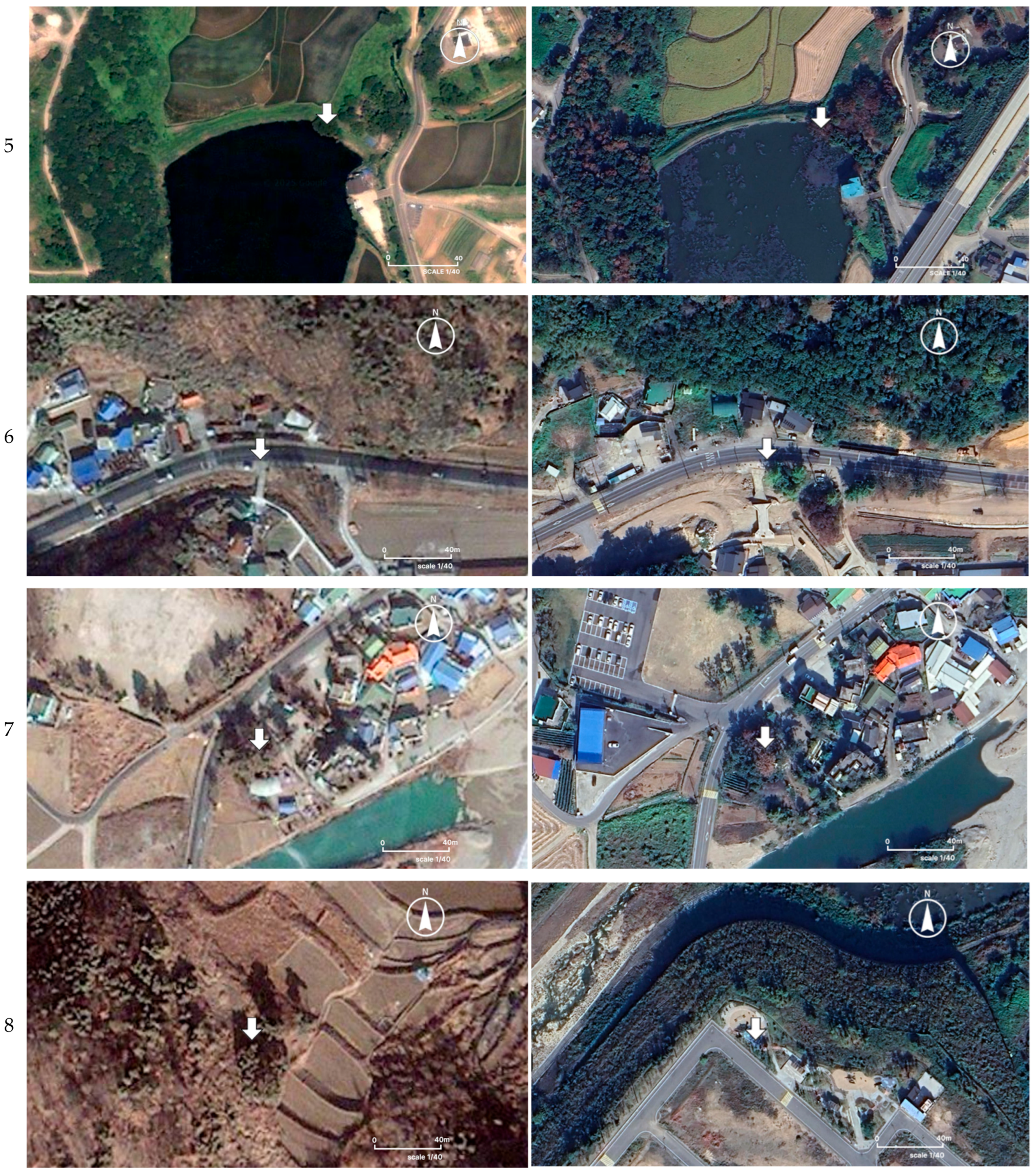

References
- Ahn, S.; Dedekorkut-Howes, A. The Heat Is on: How Well Are Densely Populated Korean Cities Adapting to Increased Temperatures and Urban Heat Island Effect? Environments 2025, 12, 87. [Google Scholar] [CrossRef]
- Allen, C.D.; Breshears, D.D.; McDowell, N.G. On underestimation of global vulnerability to tree mortality and forest die-off from hotter drought in the Anthropocene. Ecosphere 2015, 6, 129. [Google Scholar] [CrossRef]
- Allen, C.D.; Macalady, A.K.; Chenchouni, H.; Bachelet, D.; McDowell, N.; Vennetier, M.; Kitzberger, T.; Rigling, A.; Breshears, D.D.; Hogg, E.H.; et al. A Global Overview of Drought and Heat Induced Tree Mortality Reveals Emerging Climate Change Risks for Forests. For. Ecol. Manag. 2010, 259, 660–684. [Google Scholar] [CrossRef]
- Anderegg, W.R.L.; Hicke, J.A.; Fisher, R.A.; Allen, C.D.; Aukema, J.; Bentz, B.; Hood, S.; Lichstein, J.W.; Macalady, A.K.; McDowell, N.; et al. Tree Mortality from Drought, Insects, and Their Interactions in a Changing Climate. New Phytol. 2015, 208, 674–683. [Google Scholar] [CrossRef]
- Atar, F.; Güney, D.; Bayraktar, A.; Yıldırım, N.; Turna, İ. Seasonal change of chlorophyll content (SPAD value) in some tree and shrub species. Turk. J. For. Sci. 2020, 4, 245–256. [Google Scholar] [CrossRef]
- Bennett, A.C.; McDowell, N.G.; Allen, C.D.; Anderson-Teixeira, K.J. Larger Trees Suffer Most During Drought in Forests Worldwide. Nat. Plants 2015, 1, 15139. [Google Scholar] [CrossRef] [PubMed]
- Climdex Project. ETCCDI/Climdex Definitions of Climate Extremes Indices. Available online: https://www.climdex.org/learn/indices/ (accessed on 17 September 2025).
- Donnelly, A.B.; Yu, R.; Rehberg, C.; Meyer, G.; Young, E.B. Leaf chlorophyll estimates of temperate deciduous shrubs during autumn senescence using a SPAD-502 meter and calibration with extracted chlorophyll. Ann. For. Sci. 2020, 77, 30. [Google Scholar] [CrossRef]
- Fay, N. Environmental arboriculture, tree ecology and veteran tree management. Arboric. J. 2002, 26, 213–238. [Google Scholar] [CrossRef]
- Gilbert, G.S.; Ballesteros, J.O.; Barrios-Rodriguez, C.A.; Bonadies, E.F.; Cedeño-Sánchez, M.L.; Fossatti-Caballero, N.J.; Trejos-Rodríguez, M.M.; Pérez-Suñiga, J.M.; Holub-Young, K.S.; Henn, L.A.W.; et al. Use of Sonic Tomography to Detect and Quantify Wood Decay in Living Trees. Appl Plant Sci 2016, 4, 1–13. [Google Scholar] [CrossRef] [PubMed]
- Gilman, E.F. An Illustrated Guide to Pruning, 3rd ed.; Delmar Cengage Learning: Boston, MA, USA, 2013; p. 352. [Google Scholar]
- Grossiord, C.; Buckley, T.N.; Cernusak, L.A.; Novick, K.A.; Poulter, B.; Siegwolf, R.T.W.; Sperry, J.S.; McDowell, N.G. Plant responses to rising vapor pressure deficit. New Phytol. 2020, 226, 1550–1566. [Google Scholar] [CrossRef]
- Hanum, S.F.; Darma, I.D.P.; Atmaja, M.B.; Oktavia, G.E.A. Tree Risk Assessment with Sonic Tomograph Method at Bali Botanical Garden. J. Manaj. Hutan Trop. 2020, 26, 233–243. [Google Scholar] [CrossRef]
- Hirons, A.D.; Thomas, P.A. Applied Tree Biology; Wiley-Blackwell: Hoboken, NJ, USA, 2018. [Google Scholar]
- IPCC. Climate Change 2023: Synthesis Report; Contribution of working groups I, II and III to the sixth assessment report of the Intergovernmental Panel on Climate Change; Lee, H., Romero, J., Eds.; Intergovernmental Panel on Climate Change: Geneva, Switzerland, 2023. [Google Scholar]
- Jim, C.Y.; Ng, E. Urban forestry as a climate mitigation strategy using tree canopy in compact cities. Landsc. Urban Plan. 2018, 169, 250–264. [Google Scholar] [CrossRef]
- Jung, J.S.; Lee, G.G.; Son, J.W.; Kim, C.W.; Ahn, Y.J. Photosynthetic responses of large old Zelkova serrata trees to different growth environments. Sci. Rep. 2023, 13, 20205. [Google Scholar] [CrossRef]
- Kim, H.J.; Yoon, Y.H.; Park, B.J.; Kim, W.T. A Study on the Growth Environment and Management of Protected Trees in Seoul- Focused on Zelkova serrata. J. Korean Inst. Tradit. Landsc. Archit. 2007, 25, 127–140. [Google Scholar]
- Korea Meteorological Administration (KMA). Impact-Based Heat Wave Forecasts (Industry Leaflet). Available online: https://www.weather.go.kr/wnuri_help/doc/heatwave_leaflet_eng.pdf (accessed on 19 October 2025).
- Lindenmayer, D.B.; Laurance, W.F.; Franklin, J.F. New insights into the value of large old trees. Trends Ecol. Evol. 2014, 29, 364–371. [Google Scholar]
- Kobayashi, H.; Kondo, R.; Yamaguchi, Y. Parameter Identification of a Stomatal Conductance Model for the Prediction of Evapotranspiration from Zelkova serrata Street Trees. J. Environ. Eng. 2021, 86, 377–387. [Google Scholar] [CrossRef]
- Mattheck, C.; Bethge, K.; Webber, K. The Body Language of Trees: Encyclopedia of Visual Tree Assessment; Karlsruhe Institute of Technology: Karlsruhe, Germany, 2015; p. 548. [Google Scholar]
- McDowell, N.; Pockman, W.T.; Allen, C.D. Mechanisms of Plant Survival and Mortality during Drought: Why Do Some Plants Survive While Others Succumb? New Phytol. 2008, 178, 719–739. [Google Scholar] [CrossRef]
- Monserud, R.A.; Sterba, H. Modeling individual tree mortality for Austrian forest species. For. Ecol. Manag. 1999, 113, 109–123. [Google Scholar] [CrossRef]
- Munné-Bosch, S. Limits to tree growth and longevity. Trends Plant Sci. 2018, 23, 985–993. [Google Scholar] [CrossRef]
- National Research Institute of Cultural Heritage. Manual for Risk Diagnosis of Natural Monument Veteran Trees; National Research Institute of Cultural Heritage: Daejeon, Republic of Korea, 2016; p. 53. (In Korean) [Google Scholar]
- Wonn, H.T.; O’Hara, K.L. Height:Diameter Ratios and Stability Relationships for Four Northern Rocky Mountain Tree Species. West. J. Appl. For. 2001, 16, 87–94. [Google Scholar] [CrossRef]
- Pearson, R.G.; Phillips, S.J.; Loranty, M.M.; Beck, P.S.A.; Damoulas, T.; Knight, S.J.; Goetz, S.J. Shifts in Arctic vegetation and associated feedbacks under climate change. Nat. Clim. Change 2013, 3, 673–677. [Google Scholar] [CrossRef]
- Quinteros-Gómez, Y.; Angulo, A.; Rojas-Briceño, N.B.; Medina-Sánchez, J.; Huamán-Delgado, M.; Sarmiento, L.; Balarezo, E.; Portocarrero, J.; Arce-Peña, N. Noninvasive Sonic Tomography for the Detection of Internal Defects in Relict Woodlands of Polylepis in Peru. Forests 2025, 16, 957. [Google Scholar] [CrossRef]
- Hamed, K.H. Trend Detection in Hydrologic Data: The Mann–Kendall Trend Test under the Scaling Hypothesis. J. Hydrol. 2008, 349, 350–363. [Google Scholar] [CrossRef]
- Sekertekin, A.; Bonafoni, S.; Bektas Balcik, F. Land Surface Temperature Retrieval from Landsat 5, 7, and 8 Over Rural Areas: Assessment of Accuracy and Comparison of Different Emissivity Models. Remote Sens. 2020, 12, 294. [Google Scholar] [CrossRef]
- Zhang, L.; Zhang, Y.; Qin, Q.; Li, W.; Chen, H. Retrieval and Validation of Land Surface Temperature from Landsat 8 TIRS Using Various Emissivity Models and Atmospheric Correction Algorithms. Remote Sens. 2022, 14, 2105. [Google Scholar] [CrossRef]
- Rao, S.; Allen, C.D.; Breshears, D.D.; Macalady, A.K. Climate-induced tree mortality in North America: A review of patterns and mechanisms. Forests 2020, 11, 797. [Google Scholar]
- Uddling, J.; Gelang-Alfredsson, J.; Piikki, K.; Pleijel, H. Evaluating the relationship between leaf chlorophyll concentration and SPAD-502 chlorophyll meter readings. Photosynth. Res. 2007, 91, 37–46. [Google Scholar] [CrossRef]
- Harris, R.W.; Clark, J.R.; Matheny, N.P. Arboriculture: Integrated Management of Landscape Trees, Shrubs, and Vines, 6th ed.; Bioscience Publishing: Richmond, BC, Canada, 2021; p. 417. [Google Scholar]
- Yue, S.; Wang, C.Y. The Mann–Kendall Test Modified by Effective Sample Size to Detect Trend in Serially Correlated Hydrological Series. Water Resour. Manag. 2004, 18, 201–218. [Google Scholar] [CrossRef]
- Burnham, K.P.; Anderson, D.R. Model Selection and Multimodel Inference: A Practical Information-Theoretic Approach, 2nd ed.; Springer: New York, NY, USA, 2002. [Google Scholar]
- Roman, L.A.; Battles, J.J.; McBride, J.R. Urban Tree Mortality: A Primer on Demographic Approaches; Technical Report NRS-158; U.S. Department of Agriculture, Forest Service, Northern Research Station: Newtown Square, PA, USA, 2016; p. 24. [Google Scholar]
- Ryan, M.G.; Yoder, B.J. Hydraulic Limits to Tree Height and Tree Growth. BioScience 1997, 47, 235–242. [Google Scholar] [CrossRef]
- Seidl, R.; Thom, D.; Kautz, M.; Martin-Benito, D.; Peltoniemi, M.; Vacchiano, G.; Wild, J.; Ascoli, D.; Petr, M.; Honkaniemi, J.; et al. Forest Disturbances under Climate Change. Nat. Clim. Change 2017, 7, 395–402. [Google Scholar] [CrossRef]
- Sepúlveda, P.; Johnstone, D.M. A novel way of assessing plant vitality in urban trees: Comparison between bark and leaf chlorophyll fluorescence and visual vitality index. Forests 2018, 10, 2. [Google Scholar] [CrossRef]
- Son, J.; Lee, G.; Shin, J. Reliability of noninvasive sonic tomography for the detection of internal defects in old, large trees of Abies holophylla Maxim. Forests 2021, 12, 1131. [Google Scholar] [CrossRef]
- Stephenson, N.L.; Das, A.J.; Condit, R.; Russo, S.E.; Baker, P.J.; Beckman, N.G.; Zavala, M.A. Rate of tree carbon accumulation increases continuously with tree size. Nature 2014, 507, 90–93. [Google Scholar] [CrossRef] [PubMed]
- Stevens-Rumann, C.S.; Kemp, K.B.; Higuera, P.E.; Harvey, B.J.; Rother, M.T.; Donato, D.C.; Morgan, P.; Veblen, T.T. Evidence for declining forest resilience to wildfires under climate change. Ecol. Lett. 2018, 21, 243–252. [Google Scholar] [CrossRef] [PubMed]
- Stovall, A.E.L.; Shugart, H.; Yang, X. Tree height explains mortality risk during an intense drought. Nat. Commun. 2019, 10, 4385. [Google Scholar] [CrossRef] [PubMed]
- Williams, A.P.; Allen, C.D.; Millar, C.I.; Swetnam, T.W.; Michaelsen, J.; Still, C.J.; Leavitt, S.W. Forest responses to increasing aridity and warmth in the southwestern United States. Proc. Natl. Acad. Sci. USA 2010, 107, 21289–21294. [Google Scholar] [CrossRef]
- Korea Forest Service. Status of Designated Protected Trees in Korea as of the End of December 2023; Forest Environment Protection Division, Korea Forest Service: Daejeon, Republic of Korea, 2024; Available online: https://www.forest.go.kr (accessed on 19 October 2025).




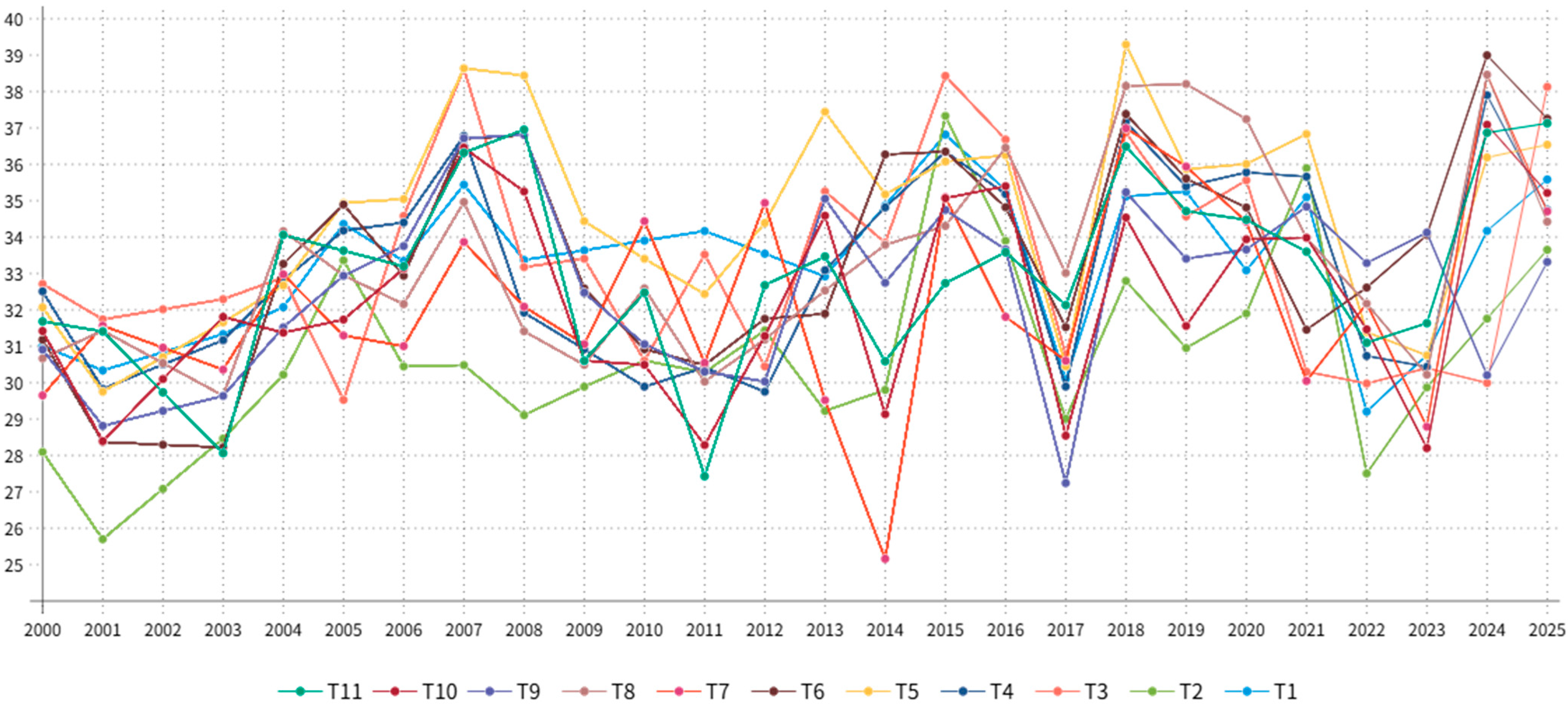
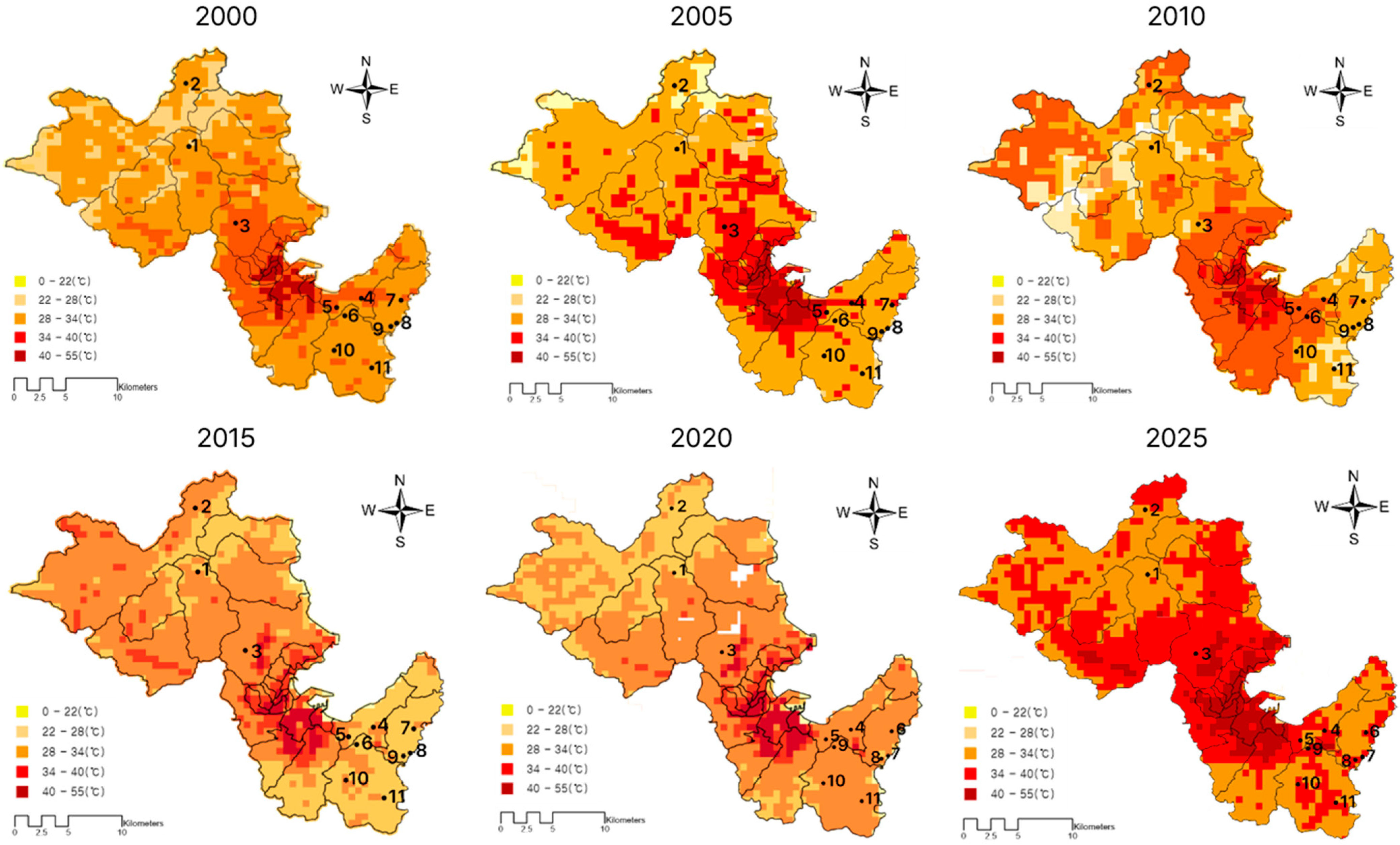
| Evaluation Indicator | Formula | Vulnerability Assessment Criteria | Notes | |
|---|---|---|---|---|
| Tapering | Tree height (TH)/Diameter at breast height (DBH) | <40: Low | 40~50: Moderate | 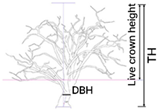 |
| 50~60: Likely | >60: High | |||
| Live Crown Ratio | Height of live crown/ Total tree height | >0.6: Low | 0.6~0.4: Moderate | |
| 0.4~0.2: Likely | <0.2: High | |||
| Branch Attachment Strength | Branch diameter(BD)/Stem diameter(SD) | <0.25: Low | 0.25~0.5: Moderate |  |
| 0.5~0.75: Likely | >0.75: High | |||
| Branch crotch Angle | Branch angle (°) | >70°: Low | 50~70°: Moderate |  |
| 30~50°: Likely | >30°: High | |||
| Stem Lean | Angle between the vertical ground line and the trees center of gravity | <10°: Low | 10~15°: Moderate | 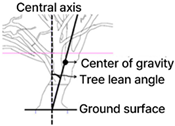 |
| 15~20°: Likely | >20°: High | |||
| No. | Location | Age (Year) | DBH (m) | Height (m) | Canopy Spread (m) | |
|---|---|---|---|---|---|---|
| Longitude | Latitude | |||||
| 1 | 129.2458° | 36.19671° | 408 | 6.2 | 30 | 28.5 |
| 2 | 129.2424° | 36.2845° | 333 | 3.5 | 23 | 19 |
| 3 | 129.311° | 36.08906° | 543 | 3.55 | 28.5 | 23 |
| 4 | 129.4868° | 35.98438° | 333 | 4.4 | 12.2 | 9 |
| 5 | 129.4527° | 35.97121° | 343 | 4.5 | 16.2 | 13 |
| 6 | 129.5423° | 35.98209° | 183 | 2.5 | 16.9 | 13 |
| 7 | 129.5375° | 35.94889° | 493 | 5 | 12.5 | 10 |
| 8 | 129.5284° | 35.94486° | 393 | 4.6 | 11.5 | 12.5 |
| 9 | 129.4638° | 35.96058° | 343 | 4.8 | 21 | 15 |
| 10 | 129.4492° | 35.91171° | 306 | 2.4 | 15 | 12 |
| 11 | 129.5016° | 35.88731° | 443 | 2.7 | 20 | 16 |
| Mean ± SD | - | 375 ± 113 | 4.01 ± 1.19 | 18.85 ± 6.31 | 14.86 ± 6.64 | |
| No. | East (SPAD Units) | West (SPAD Units) | South (SPAD Units) | North (SPAD Units) | Ave. (SPAD Units) | Vigor Rating |
|---|---|---|---|---|---|---|
| 1 | 49.613 | 39.738 | 47.157 | 48.088 | 46.149 | high |
| 2 | 43.712 | 37.475 | 41.8 | 48.525 | 42.878 | high |
| 3 | 32.783 | 31.457 | 31.117 | 32.884 | 32.06 | moderate |
| 4 | 35.963 | 40.738 | 36.713 | 36.663 | 37.519 | moderate |
| 5 | 40.588 | 30.65 | 35.238 | 39.363 | 36.46 | moderate |
| 6 | 34.788 | 35.375 | 37.338 | 29.688 | 34.297 | moderate |
| 7 | 37.388 | 39.65 | 35.325 | 28.938 | 35.325 | moderate |
| 8 | 36.413 | 40.388 | 37.375 | 38.138 | 38.079 | moderate |
| 9 | 37.05 | 38.313 | 22.013 | 36.163 | 33.384 | moderate |
| 10 | 43.188 | 39.113 | 37.613 | 47.25 | 41.791 | high |
| 11 | 33.325 | 28.888 | 41.338 | 30.15 | 33.675 | moderate |
| No. | T (1) | LCR (2) | BAS (3) | BCA (4) | SL (5) | |||||
|---|---|---|---|---|---|---|---|---|---|---|
| Value | Rating | Value | Rating | Value | Rating | Value | Rating | Value | Rating | |
| 1 | 39 | Low | 0.8 | Low | 0.48 | Moderate | 64 | Moderate | 6 | Low |
| 2 | 64 | High | 0.8 | Low | 0.3 | Moderate | 49.5 | Likely | 13.5 | Moderate |
| 3 | 46 | Moderate | 0.2 | Moderate | 0.42 | Moderate | 56 | Moderate | 9 | Low |
| 4 | 86 | High | 0.2 | Moderate | 0.74 | Likely | 59 | Moderate | 10.6 | Moderate |
| 5 | 80 | High | 0.2 | Moderate | 0.3 | Moderate | 46 | Likely | 23 | High |
| 6 | 81 | High | 0.1 | High | 0.34 | Moderate | 64 | Moderate | 38 | High |
| 7 | 70 | High | 0.2 | High | 0.52 | Moderate | 69 | Moderate | 23 | High |
| 8 | 64 | High | 0.24 | Likely | 0.4 | Moderate | 67 | Moderate | 13 | Moderate |
| 9 | 59 | Likely | 0.13 | High | 0.4 | Moderate | 74 | Low | 9 | Low |
| 10 | 56 | Likely | 0.7 | Low | 0.21 | Low | 63 | Moderate | 11 | Moderate |
| 11 | 66 | High | 0.2 | Moderate | 0.8 | High | 70 | Moderate | 14 | Moderate |
| Mean ± SD | 64.64 ± 14.50 | 0.34 ± 0.28 | 0.45 ± 0.18 | 61.95 ± 8.65 | 15.46 ± 9.22 | |||||
| No. | Measured Height (GL + m) | Estimated Damaged Area (1) (%) | Sound Wood Ratio (2) (%) | Risk Grade (3) |
|---|---|---|---|---|
| 1 | 1.00 m | 63 | 37 | E |
| 2 | 0.85 m | 14 | 74 | B |
| 3 | 0.80 m | 33 | 47 | C |
| 4 | 0.70 m | 33 | 54 | C |
| 5 | 0.55 m | 32 | 54 | C |
| 6 | 1.60 m | 25 | 56 | C |
| 7 | 1.00 m | 28 | 51 | C |
| 8 | 0.68 m | 36 | 49 | C |
| 9 | 1.00 m | 1 | 94 | A |
| 10 | 0.70 m | 41 | 48 | C |
| 11 | 0.80 m | 22 | 66 | C |
| Mean ± SD | - | 29.82 ± 15.68 | 57.27 ± 15.61 | - |
| Variable | Station | Kendall’s Tau | p-Value | Sen’s Slope | Trend Direction |
|---|---|---|---|---|---|
| Hot 30_days | 804 | 0.5390 | 0.0000951 | 2.92 | ↗ |
| 816 | −0.4521 | 0.00106 | −1.4 | ↘ | |
| 830 | 0.6974 | 0.000000715 | 0.6 | ↗ | |
| Hot 35_days | 804 | 0.697 | 0.000000715 | 1.2 | ↗ |
| 816 | −0.523 | 0.000238 | −1.33 | ↘ | |
| 830 | 0.680 | 0.000000834 | 0.544 | ↗ | |
| PRCP_sum_mm | 804 | −0.1852 | 0.182138 | −11.4583 | - |
| 816 | −0.2821 | 0.041053 | −17.6667 | ↘ | |
| 830 | −0.1396 | 0.316995 | −7.25 | - | |
| VPD_mean_kPa | 804 | 0.1509 | 0.281295 | 0.0011 | - |
| 816 | −0.4245 | 0.001573 | −0.0044 | ↘ | |
| 830 | 0.6125 | 0.000002 | 0.0049 | ↗ | |
| VPD_p95 kPa | 804 | −0.1054 | 0.456649 | −0.0018 | - |
| 816 | −0.5157 | 0.00009 | −0.0169 | ↘ | |
| 830 | 0.5556 | 0.00002 | −0.0294 | ↘ | |
| RH_mean_pct | 804 | −0.1795 | 0.198177 | −0.1962 | - |
| 816 | 0.5157 | 0.00009 | 0.2076 | ↗ | |
| 830 | −0.5271 | 0.000059 | −0.2306 | ↘ |
| No. | LST_Mean | Slope | R2 | p-Value | MK_p | SenSlope | AIC | BIC | DW | DW_p | Shapiro_p |
|---|---|---|---|---|---|---|---|---|---|---|---|
| 1 | 33.2937 | 33.2524 | 0.0762 | 0.1724 | 0.0580 | 0.1251 | 113.069 | 116.843 | 1.480 | 0.056 | 0.213 |
| 2 | 30.7224 | 31.4270 | 0.2273 | 0.0138 | 0.0106 | 0.1657 | 122.633 | 126.408 | 1.848 | 0.270 | 0.340 |
| 3 | 33.3210 | 33.8463 | 0.0072 | 0.6812 | 0.6593 | 0.0580 | 132.094 | 135.868 | 1.708 | 0.163 | 0.129 |
| 4 | 33.1630 | 35.3938 | 0.1426 | 0.0572 | 0.0580 | 0.1490 | 125.323 | 129.097 | 1.578 | 0.092 | 0.293 |
| 5 | 34.4949 | 36.0091 | 0.0968 | 0.1219 | 0.0524 | 0.1428 | 128.467 | 132.241 | 1.459 | 0.049 | 0.351 |
| 6 | 33.4413 | 34.8134 | 0.2963 | 0.0040 | 0.0219 | 0.2159 | 126.704 | 130.478 | 1.186 | 0.008 | 0.117 |
| 7 | 32.2493 | 33.7859 | 0.0979 | 0.1196 | 0.1339 | 0.1168 | 130.849 | 134.623 | 2.256 | 0.672 | 0.687 |
| 8 | 33.2763 | 34.3079 | 0.2904 | 0.0045 | 0.0082 | 0.1811 | 120.826 | 124.601 | 1.644 | 0.125 | 0.481 |
| 9 | 32.5271 | 33.6575 | 0.0783 | 0.1662 | 0.1339 | 0.1182 | 123.579 | 127.353 | 1.533 | 0.074 | 0.780 |
| 10 | 32.2717 | 33.9403 | 0.0783 | 0.1662 | 0.2517 | 0.1146 | 127.816 | 131.591 | 2.048 | 0.462 | 0.919 |
| 11 | 32.9518 | 33.5828 | 0.1439 | 0.0559 | 0.0707 | 0.1188 | 124.089 | 127.863 | 1.548 | 0.080 | 0.987 |
Disclaimer/Publisher’s Note: The statements, opinions and data contained in all publications are solely those of the individual author(s) and contributor(s) and not of MDPI and/or the editor(s). MDPI and/or the editor(s) disclaim responsibility for any injury to people or property resulting from any ideas, methods, instructions or products referred to in the content. |
© 2025 by the authors. Licensee MDPI, Basel, Switzerland. This article is an open access article distributed under the terms and conditions of the Creative Commons Attribution (CC BY) license (https://creativecommons.org/licenses/by/4.0/).
Share and Cite
Gang, E.; Cho, S.-N.; Choy, I.; Bahn, G.-S. Health Conditions of ‘Veteran Trees’ and Climate Change. Sustainability 2025, 17, 9636. https://doi.org/10.3390/su17219636
Gang E, Cho S-N, Choy I, Bahn G-S. Health Conditions of ‘Veteran Trees’ and Climate Change. Sustainability. 2025; 17(21):9636. https://doi.org/10.3390/su17219636
Chicago/Turabian StyleGang, Eunbin, Seon-Nyeo Cho, Inyoung Choy, and Gwon-Soo Bahn. 2025. "Health Conditions of ‘Veteran Trees’ and Climate Change" Sustainability 17, no. 21: 9636. https://doi.org/10.3390/su17219636
APA StyleGang, E., Cho, S.-N., Choy, I., & Bahn, G.-S. (2025). Health Conditions of ‘Veteran Trees’ and Climate Change. Sustainability, 17(21), 9636. https://doi.org/10.3390/su17219636







